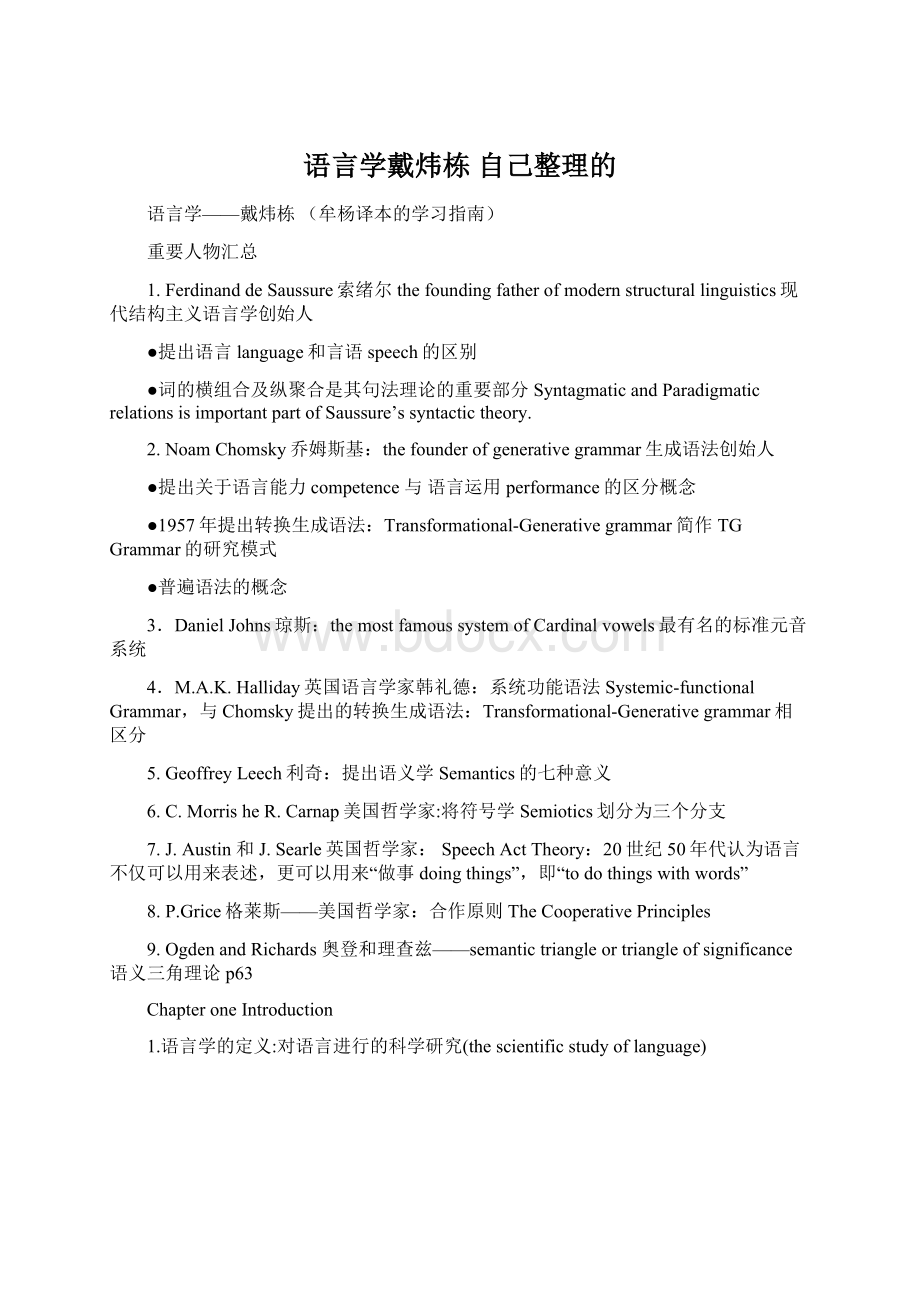语言学戴炜栋 自己整理的.docx
《语言学戴炜栋 自己整理的.docx》由会员分享,可在线阅读,更多相关《语言学戴炜栋 自己整理的.docx(22页珍藏版)》请在冰豆网上搜索。

语言学戴炜栋自己整理的
语言学——戴炜栋(牟杨译本的学习指南)
重要人物汇总
1.FerdinanddeSaussure索绪尔thefoundingfatherofmodernstructurallinguistics现代结构主义语言学创始人
●提出语言language和言语speech的区别
●词的横组合及纵聚合是其句法理论的重要部分SyntagmaticandParadigmaticrelationsisimportantpartofSaussure’ssyntactictheory.
2.NoamChomsky乔姆斯基:
thefounderofgenerativegrammar生成语法创始人
●提出关于语言能力competence与语言运用performance的区分概念
●1957年提出转换生成语法:
Transformational-Generativegrammar简作TGGrammar的研究模式
●普遍语法的概念
3.DanielJohns琼斯:
themostfamoussystemofCardinalvowels最有名的标准元音系统
4.M.A.K.Halliday英国语言学家韩礼德:
系统功能语法Systemic-functionalGrammar,与Chomsky提出的转换生成语法:
Transformational-Generativegrammar相区分
5.GeoffreyLeech利奇:
提出语义学Semantics的七种意义
6.C.MorrisheR.Carnap美国哲学家:
将符号学Semiotics划分为三个分支
7.J.Austin和J.Searle英国哲学家:
SpeechActTheory:
20世纪50年代认为语言不仅可以用来表述,更可以用来“做事doingthings”,即“todothingswithwords”
8.P.Grice格莱斯——美国哲学家:
合作原则TheCooperativePrinciples
9.OgdenandRichards奥登和理查兹——semantictriangleortriangleofsignificance语义三角理论p63
ChapteroneIntroduction
1.语言学的定义:
对语言进行的科学研究(thescientificstudyoflanguage)
2.语言学的范围语音学
音位学
语言学内部的主要分支形态学
句法学
语义学
语用学
社会语言学
跨学科分支心理语言学
应用语言学
规定性与描写性
共时性与历时性
言语与文字
3.语言学中的一些重要区分语言与言语
语言能力与语言运用
传统语法与现代语言学
4.语言的定义
5.语言的识别特征
6.语言的作用
术语双解
1.linguistics(语言学):
Linguisticsreferstothescientificstudyoflanguage.对语言进行科学研究的学科。
2.generallinguistics(普通语言学):
thestudyoflanguageasawhole.
3.phonetics(语音学):
thestudyofsoundsusedinlinguisticcommunication.
4.phonology(音韵/系/位学):
从功能的角度出发对出现在某种特定语言中的语音及其组合、分布规律进行研究的语言学分支。
Thebranchoflinguisticswhichstudiesthesoundpatternsfromfunctionperspective.
5.morphology(形态学):
研究单词的内部构造theinternalstructureofwords
6.syntax(句法):
研究组词造句的规则therulesgoverningthecombinationofwordsintosentences.
7.Semantics(语义学):
thestudyofmeaning;对语言产生的意义的方法的系统研究,以研究词义和句义为主it’sthesystemicstudiesonthemeaning-producingmechanisminlanguages,includingwordsandsentencesmeaning
8.pragmatics(语用学/论):
从语言同使用者之间的关系出发,研究在实际交际inreal-timecommunicationcontexts中影响人们语言使用的各种因素mainlyintermsoftherelationshipbetweenlanguageandlanguage-users。
9.sociolinguistics(社会语言学):
10.psycholinguistics(心理语言学):
11.appliedlinguistics(应用语言学)
①广义:
②inanarrowsense:
12.descriptive(描写性):
Prescriptive(规定性):
13.Synchronic(共时性):
以某个特定时期的语言为研究对象
Diachronic(历时性):
研究语言各个阶段的发展变化,研究语言的历史发展规律
14.speechandwriting(言语与文字)
Langue(语言):
指语言系统的整体thewholelinguisticsystem,所有语言使用个体头脑15.中存储的词语-形象word-image的总和,这个整体相对比较稳定。
Parole(言语):
指代某个个体在实际语言使用环境中说出的具体话语actualuseoflanguage,是随时间和地点变化的一个动态的、偶然性很大的实体
competence语言能力:
指理想语言使用者关于语言规则的知识储备
16.
performance语言运用:
指真实的语言使用者在实际场景中的语言使用
注与索绪尔的区别——索绪尔着重于从社会的角度socialperspective来研究语言,乔姆斯基则从语言使用者的知识构成theknowledgebaseofthelanguageusers来看待语言,如乔从心理学的角度来分析语言
区别:
17.traditionalgrammar:
1)Regardsthewrittenlanguageasprimary2)Forcelanguagegetsintoa
Latin-basedframework
andmodernlinguistics:
1)Regardsthespokenlanguageasprimary,notthewritten2)Viceversa
(3点区别):
18.language(语言)-定义理解及特点:
19.designfeaturesoflanguage语言的识别特征:
㈠designfeature识别特征(定义):
㈡特征:
①arbitrariness(任意性):
shu和Tree都能表示“树”这一概念;同样的声音,各国不同的表达方式
②productivity(能产性):
语言可以理解并创造无限数量的新句子,是由双层结构造成的结果(Understandandcreateunlimitednumberwithsentences)
③duality(双重性):
语言由声音结构和意义结构组成(thestructureofsoundsandmeaning)
④displacement(移位性-不受时空限制的特征):
可以表达许多不在场的东西,如过去的经历、将来可能发生的事情,或者表达根本不存在的东西等
⑤culturaltransmission(文化传承性):
语言需要后天在特定文化环境中掌握
20.functionsoflanguage(语言的作用)
第二章Phonology(音韵/系/位学)
Articulatoryphonetics(发音语音学)
1.phonetics(语音学):
auditoryphonetics(听觉语音学)
Acousticphonetics(声学语音学)
了解Spectrographs(频谱仪)vocalcords(声带)
thePharynx(orpharyngealcavity)咽腔voicing(浊化)
2.organsofspeechvoiceless(轻音)
(发音器官)theoralcavity口腔(关于口腔——舌头,见下表)
thenasalcavity鼻腔(何时会鼻音化)
方式
器官
音
Obstruction
Backofthetongue(舌后)andvelararea(软腭音)
[k]、[g]
Narrowthespace
Hardpalate(硬腭)andfrontoftongue(舌前)
[j]
Obstruction
Thetipofthetongue(舌尖)andalveolarridge(齿龈)
[t]、[d]
Partialobstruction
Upperfrontteeth(前齿上部)andtipofthetongue(舌尖)
[θ]、[ð]
Obstruction
Upperteeth(上齿)andlowerlip(下唇)
[f]、[v]
Obstruction
Lips
[p]、[b]
3.Internationalphoneticalphabet(IPA)国际音标/国际语音字母表:
19th末,westernscholarsfeeltheneedforastandardizedandinternationallyacceptedsystemofphonetictranscription.(IPA应运而生)。
——thebasicprincipleofIPAisusingoneletter(selectedfrommajorEuropeanlanguages)torepresentonespeechsound(语音).
国际音标图IPAchart:
全称是InternationalPhoneticAlphabet,由国际语音协会IPA=InternationalPhoneticAssociation在1888年首次确定.
4.Diacritics(变音符):
aresymbolswhichareaddedtotheletter-symbolstobringoutthefinerdistinctionsthanthelettersalonecan’tpossibledo.
Broadtranscription(宽式标音):
isthetranscriptionwithletter-symbolsonly.
5.两种标音方式:
Narrowtranscription(严式标音):
isthetranscriptionwithletter-symbolstogetherwithDiacritics
6.英语语音的分类(theclassificationofEnglishspeechsounds)
英语元音和辅音的本质区别:
发元音(vowel)时气流从肺部出来的气流没有受到任何阻塞。
在辅音(consonants)发出的过程中气流受到了这样或那样的阻塞。
㈠辅音的两种划分标准:
发音方式(Mannersofarticulation)、发音部位(Placesofarticulation)和【清浊特征】
*按照发音方式mannersofarticulation
●*完全阻塞辅音completeobstruction/爆破音(塞音)plosives(stops):
/p/,/b//t/,/d//k/,/g/
●*擦音fricatives:
/f//v//s//z//师//3//6//咬舌z//h/
●*破(塞)擦音affricates:
/tʃ//dʒ/
●*流音liquids:
/r//l/
●*鼻音nasals:
/m//n//ŋ/
●*滑音/半元音glides/semivowels:
/w//j/
●接近辅音approximants
●中央流音central
●边流音lateral:
*按照发音部位places:
●唇间音/双唇音bilabial:
/p//b//m//w/
●唇齿音labiodental:
/f//v/
●齿(间)音dental:
/θ//ð/
●齿龈音alveolar:
/t//d//s//z//n//l//r/
●硬腭音Palatal:
/ʃ//ʒ//tʃ//dʒ//j/
●喉音glottal:
/h/
●软腭音velar:
/k//g//ŋ/
●龈腭音alveo-palatal/post-alveolar:
综合图表:
Voiced/
voiceless
bilabial
Labio-dental
dental
alveolar
palatal
velar
glottal
stops
voiceless
p
t
k
Voiced
b
d
g
fricatives
voiceless
f
θ
s
ʃ
h
Voiced
v
ð
z
ʒ
affricates
voiceless
(tʃ)
tʃ
Voiced
(dʒ)
dʒ
nasals
Voiced
m
n
ŋ
liquids
Voiced
l;r
glides
Voiced
w
特征:
*清浊特征Voicing
●分类:
浊辅音voicedconsonants清辅音voicelessconsonants
●体现形式:
声带是否震动inthevibrationofthevocalcordsE.g:
/p/和/d/
*送气特征Aspiration
●articulatedwithastrongairstreampushingout
●只有爆破音和破擦音有送气与否的区别
●不造成词义改变,是非区别性特征E.g:
/p/在please中送气,在speak中不送气
*区别性特征DistinctiveFeatures
●可以用来区分不同音位(phoneticvoicing)如清浊特征,但送气特征就不是
●区别性特征一般都是双元Binary的(+voicing/-voicing)
㈡元音的划分:
⑴thepositionofthetongueinthemouth舌的位置(即哪一部位处于最高位置)
⑵theopennessofthemouth嘴张开的程度
⑶theshapeofthelips唇的形状①rounded圆唇元音包括:
后元音中除【a:
】外的所有②unrounded不圆唇元音,为其他所有。
⑷thelengthofthevowels元音的长短①长元音,发音时喉部处于紧张状态,又称紧元音②短元音,又称松元音。
根据第一、二个划分标准有下图:
Frontcentralback
i:
u:
iu
Close
eə:
Semi-closed
əɔ:
Semi-open
æʌɔ
aa:
open
7.phonology音位学
phonology(音位学):
着重语言的自然属性physicalproperties,关注所有语言中
1.1区分人可能发出的所有声音,是音位学研究的基础
p22phonetics(语音学):
着重强调语音的社会功能socialfunctions,对象是某种语言中可以用来组合成词句的那些语音
1.2重要概念
1.2.1音素phone:
isaphoneticunitorsegment(是一个语音单位或者语音段)
1.2.2音位Phoneme:
aphonologicalunit(音位具有辨音功能)
●在语言中具有区别表义单位作用的最小语音单位thesmallestunitthatiscapableofdistinguishingorcontrastingwords,E.g:
pig和big中的/p/和/b/就是独立的音位。
1.2.3音位变体Allophones:
●没有区分表义单位作用的音段(segment)E.g:
同样/s/音,在shoe和she中读音却有差别,若把两个有差别的/s/音调换位置,并不会改变单词意义,只是有点别扭。
所以,这两音就叫做/s/的音位变体。
注:
Phoneme和Allophone的区别:
音位具有区别性,是抽象、理想化的单位,具有系统性;音位变体都属于同一个音位,他们共同代表或者源于音位,是音位在实际环境中的体现。
1.2.4最小语音对/最小对立体MinimalPairs:
whentwodifferentformsareidenticalineverywayexceptforonesoundsegmentwhichoccursinthesamepositioninthestrings.
●两个词互相之间的差别只是一个音段,E.g:
pen和pin就是M-p,可以确定/e/和/i/
1.2.5.两种分布关系
*Ø对比性分布ContrastiveDistribution
●若两个音段出现在同一个语音环境中而产生了两个不同的单词,则处于对比性分布关系。
●最小语音对中的不同音段就是这种关系。
1.2.4中的例子
*互补性分布Complementarydistribution
●若两个基本相似的音段绝不会出现在相同的语音环境中,则它们之间就是互补性分布的关系。
●E.g:
送气的p(peak)绝不会出现在s之后,而不送气的p(speak)也不会出现在词首
1.2.6音位对立phonemiccontrast
1.3一些音位学的规则(注:
支持音位模式的规程都是适用于特定语言的)
1.3.1序列规则sequentialrules:
therearerulesthatgovernthecombinationofsoundsinaparticularlanguage,theserulesarecalled*.(在某特定语言中存在支配语音组合的规则,这些规则就叫序列规则)
1.3.2同化规则assimilationrule:
theruleassimilatesonesoundtoanotherby“copying”afeatureofasequentialphoneme,thusmakingthetwophonessimilar(通过“复制”序列中音位的特征来使一个语音同化为另一个,从而使两个音素相似)
1.3.3省略规则deletionrule:
ittellsuswhenasoundistobedeletedalthoughitisorthographicallyrepresented(告诉我们一个拼写上有表现的语音在什么时候应该省略)
1.4超音段特征/超切分特征Suprasegmentalfeatures:
thephonemicfeaturesthatoccurabovethelevelofthesegmentsarecalledsuprasegmentalfeatures,thesearethephonologicalpropertiesofsuchunitsasthesyllable,thewordandthesentence.(指超出音段层面的语音特征,是指音节、词、句子这些单位的音位学特征)
Themainsuprasegmentalfeaturesincludestress,intonationandtone(重音、语调、声调)
1.4.1●重音stress:
分为单词重音和句子重音(注:
重音所在的位置可以区别意义)
*单词重音:
位置固定,可分为三级——零zero重音,次secondary重音,和主要primary重音
*句子重音:
referstotherelativeforcegiventothecomponentsofasentence(给予某个句子成分的相对力量)
——结构重音structural:
句语句之间的对比产生的某一个单词重音的变化或某一个一般不重读的单词的重读,如ThirtTEENgirlsandthirtyboys中的TEEN重读
——强调重音contrastive:
指纯粹出于交际需要对句中的任意部分进行强调,句中的任意音节都可能成为重读音节
——语法重音grammatical:
约定俗成的语法成分功能决定的重音,如重读实词,轻读虚词等
1.4.2音调/声调tone:
tonesarepitchvariations,whicharecausebythedifferentratesofvibrationofthevocalcords(指由声带振动的不同频率引起的音高变化)——注:
音高的变化像音素一样可以区别意义。
1.4.3音调intonation:
whenpitch,stressandsoundlengtharetiedtothesentenceratherthanthewordinisolation,theyarecollectivelyknownasintonation(如果音调,重音和音长与句子而不是单个的词联系起来,它们就被统称为语调)
第三章形态学morphology:
itreferstothepartofthegrammarthatisconcernedwithwordformationandwordstructure.(研究单词内部结构及其构成的规则)
1.openclasswords(开放性词)与closedclasswords(封闭词类)
2.词/语素Morpheme:
isthesmallestunitoflanguagethatcarriesinformationab